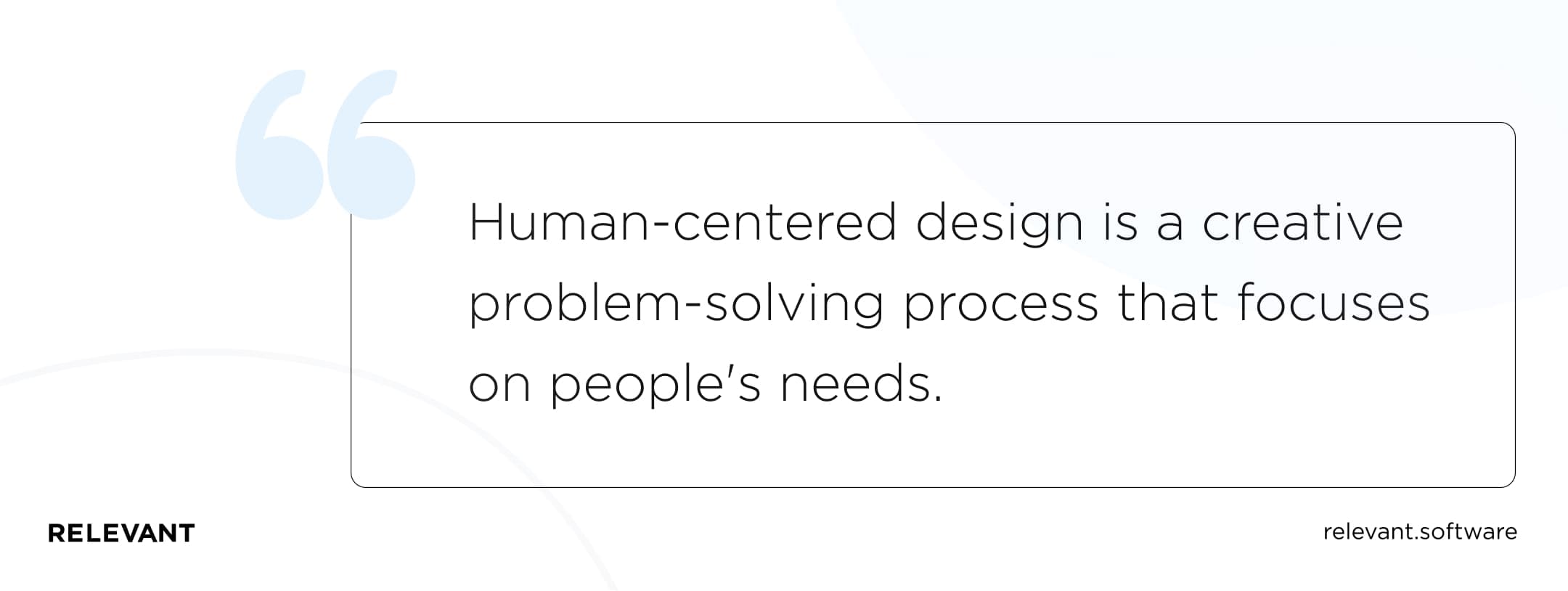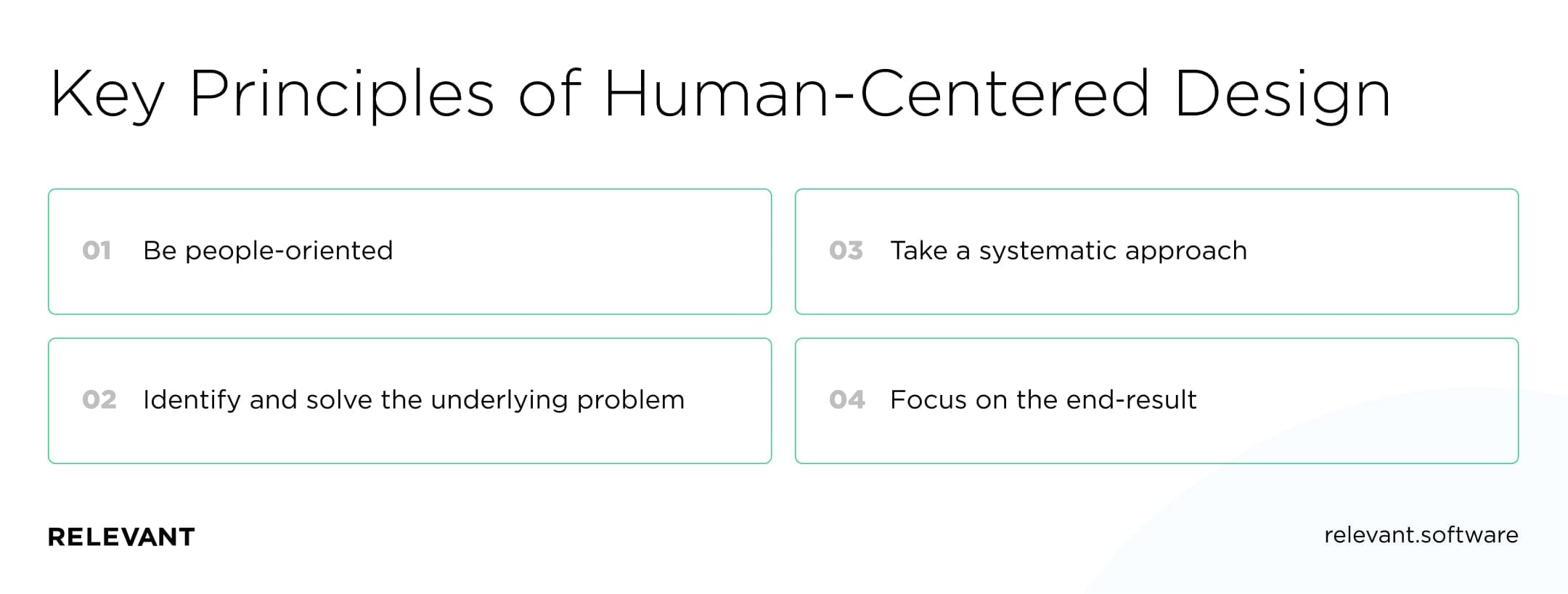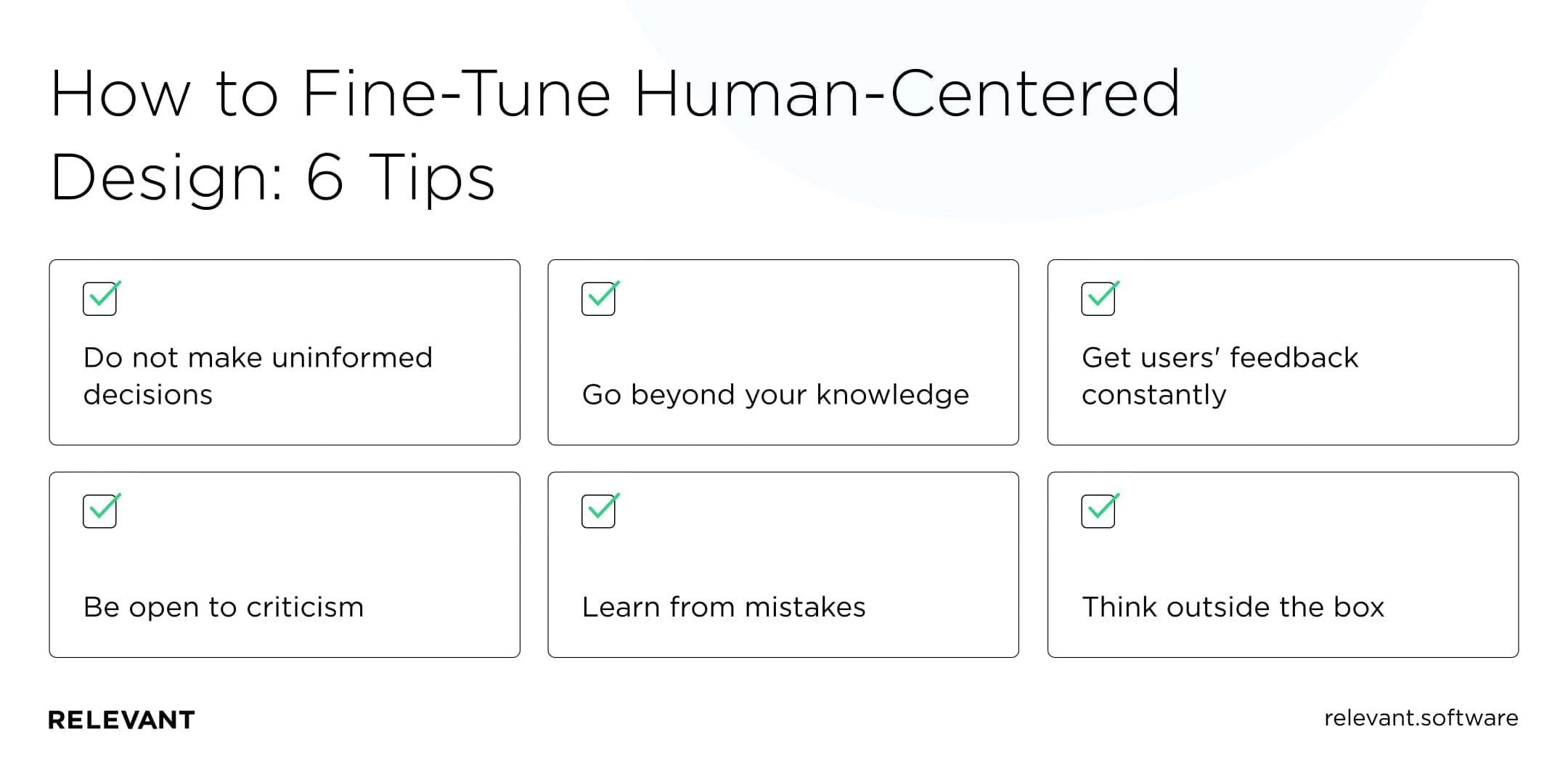Human-Centered Design Process: How It Works and Why You Need It
Updated: August 16, 2024
“Know your audience” is a sacred principle for everyone involved in user interface design and human-computer interaction. Indeed, how can you create something for people without knowing them well?
The practice shows that the companies using a human-centered design approach create solutions that resonate with the audience, ultimately contributing to engagement and growth.

We provide companies with senior tech talent and product development expertise to build world-class software. Let's talk about how we can help you.
Contact usIntuitive and easy-to-use systems and products proved to be more commercially successful. Examples of this success include Airbnb, Google, eBay, and LinkedIn, which have invested millions in creating a more coherent and seamless user experience.
We at Relevant also adhere to the principle of “customer is king.” Our core creed in custom web development has remained the same for eight years: good UI/UX design services should be human-centered.
So, in this article, we will explain the concept of human-centered design and how it differs from design thinking, show real-life examples of HCD, and share some inspirational tips.
Table of Contents
What is meant by “human-centered design”?
The term was coined by IDEO, the global design firm behind Apple’s first computer mouse and the Oral-B soft-handled children’s toothbrush. They suggested drawing inspiration from real people and even operating within market and technological constraints to consider every touchpoint with the product as an opportunity to surprise, delight, and benefit users.
So the human-centered design process of IDEO evolved into a guiding principle in developing new products.
Another term worth mentioning is “human-centered design thinking.” It is used to describe the mindset of designers who create solutions based on HCD principles. But if you delve into the comparison between human-centered design and design thinking, it becomes clear that they are not interchangeable.
Design thinking takes a macro approach, creating new products and systems to solve current or future problems. Human-centered design, meanwhile, focuses more on details and the improvement of already existing structures. Design thinking can be proactive, looking ahead to solving new problems, while the human-centered design is more reactive, reacting to inefficient systems and negative user experiences.
It should explain how problems are solved and whether the user experience meets the needs and desires of people. It’s also about results, measurable changes in customer behavior that are indicators of success and value.
Ideally, product creators should use both methodologies to create innovative, user-centric solutions because design thinking and HCD complement each other. Both seek to find problems and patterns, and both rely on iteration, continuous review, and changes to processes and products based on changing users’ needs to keep things up to date.
Human-centered design: How does it work?
The product design industry has evolved markedly over the years. So did the product design process. It now covers everything from initial market research to finalizing the product. And the creation of the visual part of the product is now built into the overall design process. In this way, design is no longer a separate activity that starts after product development.

Human-centered design is a creative problem-solving process that focuses on people’s needs. It is the foundation of the user, customer, and service experience (UX, CX, SX). But how does it work? We will now explain.
First, when designers have close contact with their clients, a more profound sense of empathy is needed to create an ethical design that respects privacy. If they genuinely empathize with the people they design for, it helps find solutions that improve their lives.
Second, a human-centered approach gives users the feeling of being understood, which increases customer loyalty. When they feel part of the process, the product becomes more meaningful, and they invest more in using it.
Finally, human-centered design research methods help businesses identify new opportunities for diversification by developing new products for existing markets or identifying new markets for existing products. When they are directly connected with their users, they can keep track of their needs as they change.
Key principles of human-centered design
According to usability experts, human-centered design is a step up from user-centered design. This practice is based on four principles:

Be people-oriented
While this principle follows logically from the definition of human-centered design, it needs more explanation. One UX saying is “walk a mile in the user’s shoes,” which reflects the main rule of HCD.
Keeping the user at the focus of the development process means that designers must view the product as a tool that can solve problems for real people. In addition to user needs, product creators must consider existing constraints, preferences, desires, and overall context. It would help if you explored all of these at every stage of the software development process.
Identify and solve the underlying problem
There are two types of problems in human-centered design: fundamental and symptomatic. The challenge is to find the real problem and solve it without being distracted by the symptoms.
At first, it may seem that the main problem lies on the surface, and you do not need to spend resources on finding it. But in this case, you may be developing a product that addresses the wrong or abstract issue that doesn’t exist.
Take a systematic approach
In our world, everything is interconnected, so fixing a local problem usually does not lead to a solution to the original problem, at least not in the long run. When applying human-centered design, you must think about the entire user journey.
For instance, if you are building an e-commerce store based on human-centered design principles, you need to put it in the customer’s shoes at every step of the buying process. It means you can’t help but optimize product searches and ignore inconvenient payment methods. The solution as a whole and each part of it must be people-oriented.
Focus on the end-result
Looking at the best human-centered design examples, you will find one thing in common: emphasizing the result, not the tool to achieve it. The UX should be clear and provide a smooth transition from one point of interaction to another.
The goal of any company is to make the app indispensable. Suppose you’re developing a new travel app and providing a good UX design. To do this, you need to explore all aspects of the traveler’s experience and anticipate and meet their specific needs in the context of likely use cases and goals.
The human-centered design phases
IDEO’s Human-Centered Design guide lists three questions to answer before implementing your project:
- Desirability (What do people want?) Scrutinize people’s basic needs to find what they find most desirable.
- Feasibility (What is technically feasible?) Having found a helpful solution, you need to understand whether it is possible to implement it.
- Sustainability (What is financially viable?) To achieve the goal, including financial benefits, you must ensure that the solution is sustainable.
This approach requires both divergent and convergent thinking. Start with general things and then move on to details. Interact with users to identify as many problems as possible and then solve them.
There are five phases in IDEO’s human-centered design thinking process, and they are:
- Observation and diving
- Making assumptions and hypotheses
- User research (Who will use this product? What are their pain points?)
- Sympathy
- Understanding the behavioral “context of use” (where, how, and by whom will the product be used?)
- Ideation
- Characters
- Empathy cards
- Customers’ journey maps
- Sketches and ideas
- Rapid prototyping: designing and testing solutions
- User reviews
- User testing and validation (does the product help solve the problem?)
- Usability testing (is the product really user-friendly?)
- Iteration
- Performance

What are the benefits of human-centered design for your app?
Human-centric design is beneficial to all parties involved in the development process.
- Benefits for users. The concept of human-centered design begins with people and their needs. As a result, users receive customized products that effectively solve their problems.
- Benefits for stakeholders. Solutions developed according to the HCD methodology have a greater potential to gain a significant market share. In addition, they increase brand loyalty as people like to feel that they are being taken care of.
- Benefits for the development teams. Human-centered design simplifies the work of designers and programmers, as they can rely on verified information based on market research and user feedback. In addition, if a team follows the system development life cycle, it is psychologically more result-oriented. It means less wasted effort so that the customer can expect faster delivery times and ROI.
Thus, human-centric design can:
- Increase sales and profit margins—customers are more likely to buy a product or service that meets their needs.
- Raise competitiveness—customers are less likely to choose other companies’ products if your product meets their needs more effectively.
- Create a positive user experience to increase loyalty and ensure a good reputation for your business or brand.
- Help gain thoughtful insights, which in turn can lead to innovative new products or services.
- Save your business time and money by testing with end-users when making changes is still cost-effective.

Businesses that prefer human-oriented design usually thrive. Their solutions are convenient and insightful; they are sensitive to their users and pay them back.
Human-centered design examples
Now that you already know human-centered design principles and benefits, let’s look at the final products made with it.
IDEO
IDEO pioneered human-centered design (HCD) by applying it to technology. In 1980, Apple asked the agency to create the device now known as the Lisa Mouse.
Issue: Previous prototypes were too big, complex, and expensive to manufacture. The new version of the mouse was supposed to cost less than 10% of the versions developed by other companies.
Solution: A portable device that fits in your hand with a rubber ball for easy movement and a large key for finger flicks.
Impact: The basic mechanisms of this original mouse are still used in almost all modern mechanical counterparts.
Intermountain Healthcare
Salt Lake City-based Intermountain Healthcare uses agile thinking to change how information moves through businesses and other groups.
Issue: A large health care provider with a lot of hospitals, clinics, and members was having a hard time delivering critical messages quickly.
Solution: Intermountain Healthcare implemented a 15-minute “meetings” system that simplifies the message delivery to the senior management and helps resolve various issues. All communications are tracked, and the results are shown to everyone in management to see how vital their work is.
Impact: In the first year, the company solved more than 365 unique complex problems, which helped to create proactive solutions and improve patient care.
Molecule
Molekule, an air-purifying company based in San Francisco, has used technology developed by scientists for more than 20 years to help allergy sufferers create an air purifying device for home use. But before that, Peter Ryring-Chekalla, the company’s vice president of products and design, met with allergy sufferers to understand why traditional air purifiers weren’t meeting their needs.
Issue: Most people didn’t know how often they should change their filters or buy replacement parts. It led to contamination of the purifiers, allergy outbreaks, and, ultimately, customer frustration.
Solution: When ordering an air purifier, customers log into a special application that automates end-user filter restocking, predicts the annual cost, and alerts customers when they need to replace the filter. And the company delivers everything they need directly to their home.
Impact: The manufacturer regularly maintains its air purifiers, reducing allergic reactions and boosting customer satisfaction.
Airbnb
In 2009, Airbnb ran into financial difficulties due to low booking rates and was close to bankruptcy. The company’s income hovered around $200 a week. This meant almost unlimited losses with zero growth.
Issue: They took a human-centered approach to identify what wasn’t working on their site and found that their poor-quality photo listings were to blame. People didn’t book because they didn’t see what they were paying for.
Solution: Airbnb decided to update all the images to be more vibrant, doubling their revenue and quickly fixing the issue.
Impact: A week later, the results were in: image enhancement doubled weekly revenue to $400 a week. At the time, it was the first financial improvement the company had seen in over eight months.
How to fine-tune human-centered design: Expert’s tips
While most of us have a basic understanding of human-focused design, few know how to apply the theory to real projects. The concept is based on general principles and does not have strict rules. But it is the best practices in the design process that produce the expected results.

Do not make uninformed decisions
Unconfirmed personal opinions about design (also known as bias) get in the way of good design. You must implement each design decision based on the information you have about your users and validate them through process testing.
Go beyond your knowledge
Your knowledge is valuable only if you remember that you don’t know everything. You must abandon your inferences and turn them into proven abilities. It is crucial to understand the specific aspects of the domain you are designing for.
Get users’ feedback constantly
When you need to work fast, collecting feedback from users can seem like an easy-to-give-up luxury. But nothing can replace the nuance and depth of understanding that you can acquire in personal communication. In this way, you can quickly test key assumptions, identify opportunities for improvement, be inspired by new ideas, and gain actionable insights on prioritizing features and functionality.
Be open to criticism
Don’t try to defend your decision against those who point out any flaws, instead use their opinion to improve your product or service further. Even when you make your final prototype, you may find flaws in your assumptions that need to be corrected.
Learn from mistakes
Human-centered design is based not only on development and testing but also on the understanding that not all solutions will work. Those who seek to solve big problems are bound to fail along the way. The willingness to test iterations of an idea before it is “done” leads to many small “failures in the process.” Bundling small failures throughout the HCD design process means you’re less likely to run into an unexpected, large, and costly failure at the end.
Think outside the box
To stay innovative, you need fresh perception. Despite the abundance of information on your computer screen, you risk mental stagnation when falling into a predictable routine. Get out into the world and contexts in which people use your product—you’ll be surprised how quickly unexpected opportunities open up.
What is the future of human-centered design?
The COVID-19 pandemic and its restrictions have caused rapid and massive changes in how we do business. Many organizations have had to adapt to new challenges to meet people’s needs more creatively. The challenge now is to build on that momentum and continue to innovate.
This is where human-centered design practices can help us. It is a powerful way to understand changing behaviors, preferences, and pain points and to focus efforts in the right places in the right way. By opening up the user’s point of view, designers can create solutions that work effectively in the new digital reality—whatever it ends up looking like.
Those who planned digital transformation used the pandemic as a catalyst to accelerate or partially complete their plans. Any digital transformation is a long and iterative process. Companies that choose human-centered processes will be better prepared for the future. This approach gives businesses a strong foundation for long-term prosperity and growth.

Keeping pace means developing processes and a culture that allows you to iterate when interacting with end-users quickly. But it is not enough to meet increased expectations and ensure reliable interaction. It is also necessary to respond promptly to sudden and unexpected changes.
As an outsourcing software development company, Relevant uses Agile methodologies in human-centered product design. Agile UX is a combination of agile and UX design methods that makes it easier for teams to work together and get feedback from users.
Conclusion
The human-centered design approach is the new standard in product development that is here to stay. It helps companies develop empathy for users and offer solutions and services that people like and are willing to pay for.
And you can take advantage of human-centered design activities for your business too. If you hire a design company that applies the HCD approach to the development process, you can ensure that your investment will not be wasted on a product no one wants to use.
Research, testing, and constant iteration guarantee that the design, marketing, and development teams are moving in the right direction, and you will get a working and profitable product.
FAQ
Our core services:
Do you want a price estimate for your project?
Do you know that we helped 200+ companies build web/mobile apps and scale dev teams?
Let's talk about your engineering needs.
Write to us











